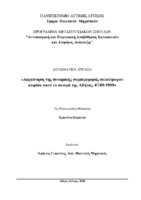| dc.contributor.advisor | Γιαρλέλης, Χρήστος | |
| dc.contributor.author | Περπινιά, Χριστίνα | |
| dc.date.accessioned | 2020-07-23T10:46:30Z | |
| dc.date.available | 2020-07-23T10:46:30Z | |
| dc.date.issued | 2020-07-10 | |
| dc.identifier.uri | http://okeanis.lib2.uniwa.gr/xmlui/handle/123456789/5340 | |
| dc.description.abstract | Η παρούσα μεταπτυχιακή εργασία αφορά τη διερεύνηση της δυναμικής συμπεριφοράς πολυώροφου κτιρίου κατά το σεισμό της Αθήνας το 1999. Στην εισαγωγή περιγράφεται η τεκτονική μορφολογία της Ελλάδας και δίνονται πληροφορίες για τον καταστροφικό σεισμό από την ενεργοποίηση του ρήγματος της Πάρνηθας. Ακολουθεί αναλυτική περιγραφή των τύπων βλαβών των δομικών στοιχείων από οπλισμένο σκυρόδεμα ύστερα από ένα σεισμικό γεγονός, καθώς και οι αδυναμίες του στατικού σχεδιασμού που κάνουν ευάλωτο ένα κτίριο σε σεισμό. Στη συνέχεια η εργασία επικεντρώνεται στο συγκεκριμένο κτίριο που βρίσκεται στη Δυτική Αττική. Το κτίριο κατασκευάστηκε η δεκαετία του '80 με τον αντισεισμικό κανονισμό του 1959. Μετά την περιγραφή του κτιρίου επισημαίνονται οι βλάβες που εμφανίστηκαν μετά τον μεγάλο σεισμό κυρίως στο ισόγειο. Ο στατικός φορέας προσομοιώνεται με τη χρήση των στατικών προγραμμάτων SeismoStruct και 3DR.STRAD. Οι αναλύσεις που πραγματοποιούνται είναι: η στατική ανελαστική ανάλυση, η δυναμική φασματική ανάλυση και η δυναμική ανάλυση χρονοϊστορίας. Μετά τη θεωρητική παρουσίαση των μεθόδων ακολουθεί η διαδικασία των αναλύσεων, τα αποτελέσματά τους και συνάγονται συμπεράσματα. Για τις αναλύσεις χρονοϊστορίας χρησιμοποιούνται τα επιταχυνσιογραφήματα του Συντάγματος, των Σεπολίων και του Κ.Ε.Δ.Ε. και συγκρίνονται τα αποτελέσματα που προέκυψαν με τις πραγματικές βλάβες του κτιρίου. Πραγματοποιούνται δύο ομάδες αναλύσεων λαμβάνοντας ή όχι υπόψη τους τοίχους πλήρωσης. Όταν λαμβάνονται υπόψη οι τοίχοι προκύπτει καλή σύγκλιση των πραγματικών βλαβών με τα αποτελέσματα των αναλύσεων. Συμπεραίνεται ότι οι βλάβες του κτιρίου οφείλονται στο φαινόμενο του μαλακού ορόφου. | el |
| dc.format.extent | 100 | el |
| dc.language.iso | el | el |
| dc.publisher | Α.Ε.Ι. Πειραιά Τ.Τ. | el |
| dc.rights | Αναφορά Δημιουργού-Μη Εμπορική Χρήση-Όχι Παράγωγα Έργα 3.0 Ελλάδα | * |
| dc.rights | Αναφορά Δημιουργού-Μη Εμπορική Χρήση-Όχι Παράγωγα Έργα 3.0 Ελλάδα | * |
| dc.rights | Αναφορά Δημιουργού-Μη Εμπορική Χρήση-Όχι Παράγωγα Έργα 3.0 Ελλάδα | * |
| dc.rights.uri | http://creativecommons.org/licenses/by-nc-nd/3.0/gr/ | * |
| dc.subject | TPSH::Τεχνολογία::Δομική Μηχανική::Αντισεισμικές Κατασκευές | el |
| dc.title | Διερεύνηση της δυναμικής συμπεριφοράς πολυώροφου κτιρίου κατά το σεισμό της Αθήνας, 07/09/1999 | el |
| dc.title.alternative | Investigation of the dynamic behavior of a multi-storey building under the 07-09-1999 Athens earthquake | el |
| dc.type | Μεταπτυχιακή εργασία | el |
| dc.contributor.committee | Δημάκος, Κωνσταντίνος | |
| dc.contributor.committee | Ρεπαπής, Κωνσταντίνος | |
| dc.contributor.committee | Πνευματικός, Νικόλαος | |
| dc.contributor.master | Αντισεισμική και Ενεργειακή Αναβάθμιση Κατασκευών και Αειφόρος Ανάπτυξη | el |
| dc.subject.keyword | ΚΑΝΕΠΕ | el |
| dc.subject.keyword | SeismoStruct | el |
| dc.subject.keyword | SeismoSignal | el |
| dc.subject.keyword | 3DR.Strad | el |
| dc.subject.keyword | Ανελαστική στατική ανάλυση | el |
| dc.subject.keyword | Σεισμοί | el |
| dc.subject.keyword | Βλάβες | el |
| dc.subject.keyword | Αθήνα | el |
| dc.subject.keyword | Δυναμική φασματική | el |
| dc.subject.keyword | Δυναμική ανάλυση χρονοϊστορίας | el |
| dc.subject.keyword | Μέθοδος Pushover | el |
| dc.description.abstracttranslated | The present postgraduate thesis deals with the investigation of the dynamic behavior of a multi-storey building, during the earthquake which took place in Athens, in 1999. The introduction describes the tectonic morphology of Greece and gives information about the catastrophic earthquake, triggered by the activation of the mount Parnitha crack. Following that, there is a detailed description of the types of damage to reinforced concrete structural elements after a seismic event, as well as the weaknesses of the static design which make a building vulnerable to an earthquake. Furthermore, the thesis focuses on a specific building located in the Western Attica area. This building was constructed during the 80's following the anti-seismic regulations issued in 1959. Following the description of the building, the damages caused by the strong earthquake, mainly on the ground floor, are pointed out. The structural model was created using the SeismoStruct and 3DR.STRAD software. The analyzes performed were static inelastic analysis, dynamic response spectrum analysis, and dynamic time-history analysis. After the theoretical description of the methods, the procedure of analysis follows, their results are presented, and conclusions are drawn. For the time-history analysis, the accelerograms from Syntagma, Sepolia and K.E.D.E. stations were used and the results were compared against the actual damages on the building. Two groups of analyzes were performed considering, or not, the infill walls. When the walls are taken into account, there is a good convergence of the actual failure with the analysis results. It is concluded that the damages to the building are due to the “soft storey” phenomenon. | el |



